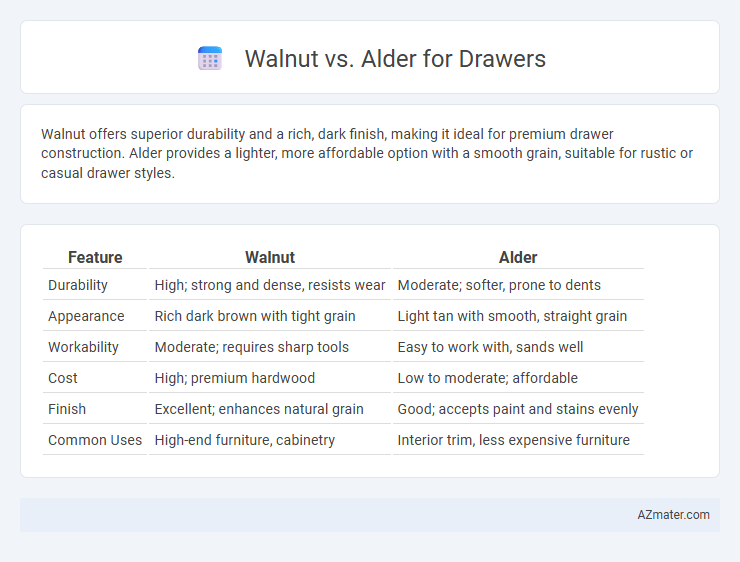Walnut offers superior durability and a rich, dark finish, making it ideal for premium drawer construction. Alder provides a lighter, more affordable option with a smooth grain, suitable for rustic or casual drawer styles.
Table of Comparison
| Feature | Walnut | Alder |
|---|---|---|
| Durability | High; strong and dense, resists wear | Moderate; softer, prone to dents |
| Appearance | Rich dark brown with tight grain | Light tan with smooth, straight grain |
| Workability | Moderate; requires sharp tools | Easy to work with, sands well |
| Cost | High; premium hardwood | Low to moderate; affordable |
| Finish | Excellent; enhances natural grain | Good; accepts paint and stains evenly |
| Common Uses | High-end furniture, cabinetry | Interior trim, less expensive furniture |
Introduction to Walnut and Alder Woods
Walnut wood, prized for its rich, dark brown color and tight grain pattern, offers durability and a luxurious finish ideal for high-end drawer construction. Alder wood presents a lighter, reddish-brown hue with a fine, consistent grain, making it a cost-effective and versatile choice for drawer cabinetry. Both woods provide strong structural integrity, but walnut is often favored for upscale aesthetics while alder suits more traditional or transitional designs.
Key Characteristics of Walnut Wood
Walnut wood is prized for its rich, dark brown color with purplish undertones and tight, straight grain, making it an elegant choice for drawer construction. Its high durability and resistance to warping ensure long-lasting structural integrity, while the smooth texture enhances both aesthetic appeal and ease of finishing. Compared to Alder, Walnut offers superior hardness and natural resistance to dents and scratches, ideal for high-use furniture pieces like drawers.
Key Characteristics of Alder Wood
Alder wood features a fine, straight grain with a smooth texture, making it ideal for drawer construction due to its ease of staining and finishing. It is lighter and softer than walnut, offering good workability and moderate durability suitable for everyday use. Its uniform color ranges from light brown to reddish hues, providing a warm, natural look that contrasts with walnut's darker, richer tones.
Durability and Strength Comparison
Walnut offers superior durability and strength compared to alder, making it an ideal choice for drawer construction where long-lasting performance is essential. Walnut's dense, tight grain structure provides enhanced resistance to dents and scratches, ensuring drawers maintain their integrity over time. Alder, while softer and more prone to wear, is easier to work with and more affordable but sacrifices durability and strength for cost-effectiveness.
Aesthetic Differences: Color and Grain
Walnut offers a rich, dark brown color with deep, intricate grain patterns that create a luxurious and elegant look for drawers. Alder wood features a lighter, warm reddish-brown hue with a straighter, more uniform grain, resulting in a softer and more casual aesthetic. The choice between walnut and alder influences the visual impact of furniture, with walnut providing sophistication and alder delivering a subtle, rustic charm.
Workability: Cutting, Shaping, and Sanding
Walnut offers excellent workability due to its fine, straight grain, making it easier to cut, shape, and sand with minimal tearing or splintering. Alder, while softer and lightweight, can dent more easily during shaping but sands smoothly to a fine finish thanks to its uniform texture. Both woods respond well to hand and power tools, though walnut's tighter grain structure provides a cleaner edge and refined detail work for drawer construction.
Cost and Availability
Walnut drawers typically cost more due to the wood's premium quality and limited availability, often priced between $15 to $30 per board foot. Alder is more affordable, usually ranging from $4 to $8 per board foot, and is widely available, making it a budget-friendly option. Availability of walnut can be scarce depending on the region, while alder is commonly stocked by most lumber suppliers.
Suitability for Drawer Construction
Walnut offers exceptional durability and a fine, straight grain, making it ideal for high-quality drawer fronts and structural components requiring strength and visual appeal. Alder, being softer and more workable, suits drawers that prioritize ease of machining and smooth finishes but may require reinforcement for heavy use. Both woods perform well in drawer construction, with walnut preferred for longevity and luxurious aesthetics, while alder offers cost-effective versatility.
Maintenance and Longevity
Walnut drawer fronts exhibit superior durability with natural resistance to wear, requiring minimal maintenance such as periodic cleaning and occasional oiling to preserve their rich, dark finish. Alder, being a softer wood, is more prone to dents and scratches, demanding more frequent touch-ups and protective finishes to maintain its appearance over time. Both woods benefit from avoiding excessive moisture and direct sunlight to extend longevity, but walnut offers greater long-term resilience for drawer applications.
Final Considerations: Which Wood Is Better for Drawers?
Walnut offers superior durability and a rich, dark grain that enhances the aesthetic appeal of drawers, making it ideal for high-end furniture pieces. Alder, being softer and lighter, is easier to work with and more budget-friendly but may show wear faster over time. Choosing between walnut and alder depends on whether long-term durability and luxury or cost-efficiency and ease of customization are the primary priorities for your drawer construction.

Infographic: Walnut vs Alder for Drawer
 azmater.com
azmater.com